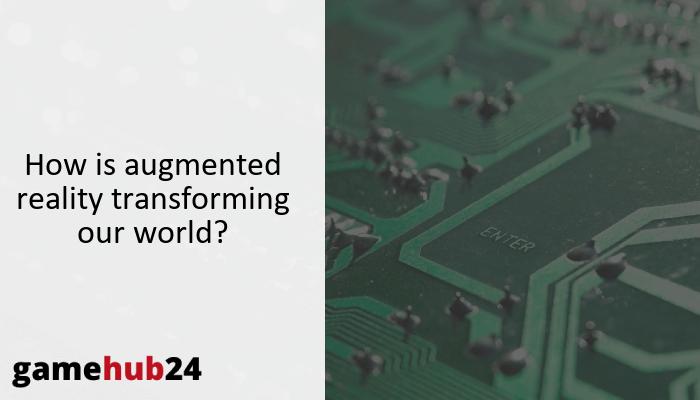A fascinating technology, augmented reality creates an immersive, interactive three-dimensional experience by blending digital information with our physical surroundings. Recognize its distinctive features, how it differs from other immersive technologies, and the critical role computer vision plays in augmented reality.
AR, which combines the digital and physical worlds, is revolutionizing a number of industries, including healthcare and education. Though latency and privacy issues remain obstacles, augmented reality (AR) has a bright future ahead of it with countless ways to be incorporated into our daily lives. Examine how augmented reality (AR) is used in wearables, games, and education. Learn about the difficulties and possibilities that lie ahead.
- AR overlays digital information onto the real world, enhancing our perception of reality.
- Key components of AR include sensors and cameras, processors, and displays.
- AR differs from VR and MR in its approach and execution.
- Computer vision is pivotal in AR, enabling the system to understand and interpret the real-world environment.
- AR is transforming various sectors, including education, gaming, and wearable technology.
- Despite challenges like latency and privacy concerns, AR’s future is promising.
What is augmented reality and how does it work?
A rapidly developing technology called augmented reality (AR) projects digital data onto the physical world to produce an interactive three-dimensional experience. It’s a virtual improvement that incorporates virtual reality with the actual world. The secret to augmented reality (AR) is its capacity to overlay digital visuals over our field of vision, enhancing our sense of realism. A difficult procedure combining tracking, rendering, and display is used to accomplish this. The augmented reality system records the user’s surroundings initially, uses this information to overlay pertinent digital content, and then shows the user the enhanced view. It’s an intriguing fusion of the digital and physical worlds with a wide range of applications in many industries.
What are the key components of augmented reality?
The main parts of augmented reality technology include CPUs, displays, sensors, and cameras. The user’s surroundings are recorded by sensors and cameras, which then transmit this data to the CPU. The processor then analyzes this data to decide the proper output, acting as the AR system’s brain. It is in charge of algorithm computations, data fusion, and graphics processing. The user is presented with the enhanced vision by the last component, the display. This might be achieved using a range of tools, including screens, headphones, glasses, and even portable electronics. Together, these components produce the immersive augmented reality experience.
How does augmented reality differ from virtual reality and mixed reality?
Although they are all forms of immersive technology, augmented reality (AR), virtual reality (VR), and mixed reality (MR) differ greatly in how they are implemented and approached. Users of VR are cut off from reality as they are fully submerged in an entirely synthetic digital world. AR, on the other hand, improves the user’s perception of reality by superimposing digital information over the actual environment. Users can interact with virtual items as if they were real thanks to mixed reality (MR), a blend of virtual reality and augmented reality. Consequently, AR and MR seek to improve our world, whereas VR provides a total escape from it.
Did you know that NASA produced the first working augmented reality system in the 1990s? It was utilized to improve human performance in remote locations and was dubbed Virtual Fixtures. The immersive experiences we enjoy now were made possible by this early use of augmented reality technology.
What is the role of computer vision in augmented reality?
A key component of augmented reality technology is computer vision. It makes it possible for the AR system to comprehend and interpret the actual world. For the purpose of accurately superimposing digital content onto the physical world, this understanding is essential. Algorithms for computer vision assist the system in identifying and detecting objects, tracking their motion, and estimating their location and orientation in space. The digital models are then rendered with the appropriate perspective and position using this information, guaranteeing a smooth transition between the virtual and physical worlds. AR wouldn’t be as attractive if it didn’t have context awareness, which is made possible by computer vision.
What are the leading platforms and tools for augmented reality?
Technology related to Augmented Reality is progressing due to a number of top platforms and tools. These include AR development kits, which give programmers the resources to construct AR applications. Examples of these are ARKit from Apple and ARCore from Google. Furthermore, wearable tech like Microsoft’s HoloLens and Google Glass is expanding the capabilities of augmented reality gear. Immersive AR experiences are also being made possible by game production tools like Unreal Engine and Unity 3D. The development of increasingly complex and immersive augmented reality apps is made possible by these cutting-edge platforms and tools.
What is the functionality of ARKit and ARCore?
Development frameworks called ARKit and ARCore were made by Apple and Google, respectively, to make it easier to create applications for augmented reality. They offer developers a set of technologies that let them superimpose digital content over the physical world. To develop immersive augmented reality experiences, ARKit and ARCore both combine motion tracking, environmental awareness, and light estimation. They enable developers to put virtual objects in the actual world, follow their movements, and modify how they look depending on the available illumination. Because of these features, ARKit and ARCore are crucial to the growth of augmented reality applications.
How are HoloLens and Google Glass contributing to augmented reality?
Wearable gear like Google Glass and HoloLens is making a big impact on the development of augmented reality. The HoloLens from Microsoft is an independent augmented reality headgear that superimposes holographic visuals on the user’s field of vision. To provide a realistic augmented reality experience, it makes use of sophisticated sensors, a high-definition 3D optical head-mounted display, and spatial sound. Conversely, Google Glass is a thin, wearable gadget that shows data in a hands-free, smartphone-like style. Users can engage with digital content in their field of view by using AR applications that are compatible with it. By pushing the limits of AR hardware, these gadgets allow for more engaging and dynamic AR experiences.
Advice: If you’re creating an augmented reality application, think about utilizing Unreal Engine or Unity 3D. These platforms facilitate the creation of immersive and engaging augmented reality experiences by offering strong support for AR developer kits such as ARKit and ARCore.
What is the role of Unity 3D and Unreal Engine in AR development?
AR development heavily relies on game development platforms such as Unreal Engine and Unity 3D. They offer the frameworks and technologies required to create interactive 3D worlds. Because of its strong support for AR development kits like ARKit and ARCore, Unity 3D is especially well-liked for AR development. It provides an extensive asset store, an easy-to-use interface, and a helpful community. The well-known Unreal Engine, which has excellent graphics, allows AR development. It offers a visual scripting framework, a potent rendering engine, and a variety of development tools. By enabling the creation of immersive AR experiences, both platforms help to expand the possibilities for AR development.
How is augmented reality applied in various sectors?
Applications for augmented reality technology are emerging in a variety of fields, including wearables, gaming, education, and healthcare. It’s changing how we engage with the world around us, learn, play, and work. Augmented Reality (AR) modifies our view of reality by superimposing digital data over the physical world, giving us new avenues for exploration and interaction. AR is transforming a number of areas of our life, whether it is teaching difficult ideas to kids, improving gaming experiences, supporting medical professionals during surgery, or giving us access to information without using our hands thanks to wearable technology.
What are the uses of augmented reality in education?
By increasing interaction and engagement, augmented reality is revolutionizing the teaching and learning process. It enables pupils to see intricate ideas that would be challenging to comprehend when taught using conventional techniques. AR, for example, may make historical events come to life, let students investigate the human body in three dimensions, or even take them on virtual field trips to distant locations. Through increasing experiential learning, augmented reality (AR) not only improves comprehension but also encourages students’ creativity and curiosity. Consequently, augmented reality (AR) is proving to be a useful tool in education, creating new avenues for instruction and learning.
How is augmented reality enhancing gaming experiences?
By fusing the real and virtual worlds, augmented reality is transforming gaming and producing immersive experiences that go beyond the screen. AR games, such as Niantic’s Pokémon Go and Snapchat’s AR games, overlay virtual aspects on the physical environment, transforming our surroundings into an interactive playground. These games promote social connection and physical activity in addition to offering a fresh gaming experience. AR is expanding the definition of gameplay and making it more dynamic and interesting by adding a layer of reality to the game experience.
What are the potential applications of AR in wearable technology?
One of the most potential markets for augmented reality applications is wearable technology. Wearables with augmented reality capabilities, such as smart glasses and headsets, allow users to view digital content in their field of vision and access it without using their hands. This has potential uses in a number of industries, including maintenance, navigation, and tourism. AR glasses have the potential to offer several functionalities such as real-time translation of foreign languages, restaurant reviews, and turn-by-turn navigation. They could give medical professionals crucial patient information while a patient is being operated on. Wearable AR technology therefore has the potential to completely change how we access and use information.

What are the challenges and future prospects of augmented reality?
Although augmented reality technology has a lot of promise, there are a number of obstacles to overcome. These cover both more general concerns like privacy and social acceptance as well as more specific ones like latency, battery life, and field of view. AR appears to have a bright future despite these obstacles. AR is predicted to become more and more ingrained in our daily lives as a result of technological breakthroughs and greater acceptance. The uses of augmented reality (AR) are virtually limitless. They can be used to enhance everyday experiences through AR glasses, revolutionize education and healthcare with AR applications, or reinvent human-computer interaction through AR interfaces.
What are the current limitations of augmented reality?
Even with all of its potential, augmented reality technology still has a number of drawbacks. These include technical difficulties with AR devices, such as their small field of view, latency problems, and short battery life. Additionally, there are problems with the user experience, like pain from extended use, a dearth of material, and trouble interacting. In addition, there are more general social challenges to think about, like privacy issues and public acceptability of augmented reality technology. To reach its full potential, AR needs to overcome these obstacles.
How is extended reality expected to evolve in the future?
Future developments are anticipated for Extended Reality (XR), which includes Augmented Reality (AR), Virtual Reality (VR), and Mixed Reality (MR). We may anticipate increasingly realistic, interactive, and immersive virtual reality experiences as a result of technological improvements. This might include MR systems that let us interact with virtual items as if they were real, VR environments that are indistinguishable from reality, and AR eyewear that seamlessly incorporate digital information into our daily lives. In addition, we should anticipate that XR will revolutionize a number of industries as it gains traction, including healthcare, education, entertainment, and business.
What are the potential impacts of immersive technology on society?
Augmented reality and other immersive technologies have the power to profoundly alter civilization. It may change the way we work, learn, play, and engage with the outside world by obfuscating the boundaries between the real and virtual worlds. It might improve interactiveness and interest in learning in the classroom. It might give medical professionals new resources for diagnosis and therapy. It might produce more engaging and immersive entertainment experiences. It also brings up significant issues with regard to ethics, privacy, and social acceptance. Because of this, as we negotiate the future of this technology, it’s critical to take its possible effects into account.

















